Post by 1dave on Dec 30, 2014 15:35:39 GMT -5
An extension of Geology for Rockhounds.
Hot Spot Theory Under Revision
We are all aware of The Hawaiian Islands, Yellowstone, and possibly the Great New England Hotspot;
but What Caused Them?
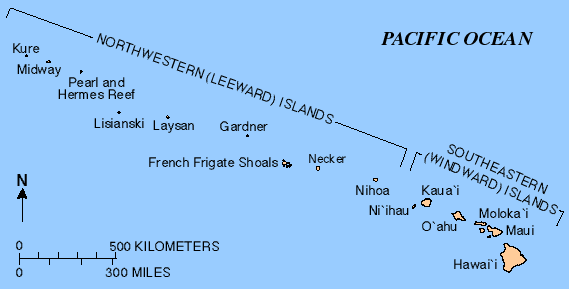
Hawaiian Hotspot as Pacific Ocean plate moves Westward. 70 million years ago to present.
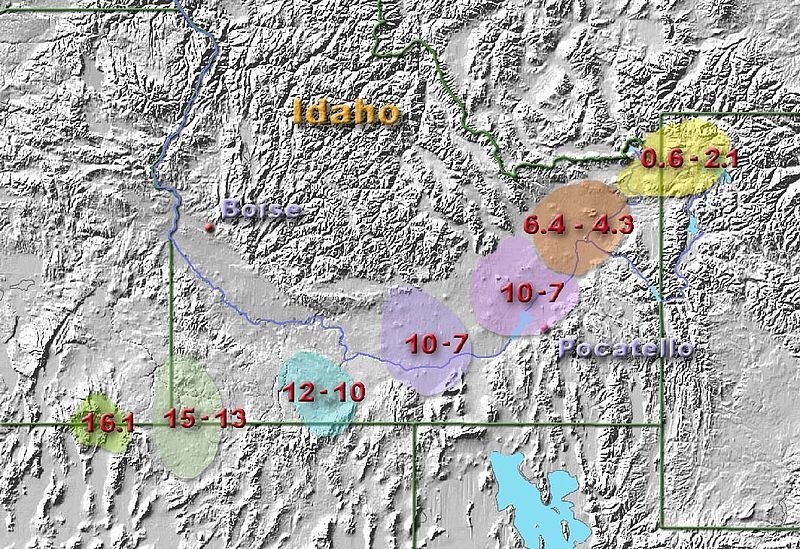
Yellowstone Hotspot over Time (16.1Ma-0.6Ma) as the Continent moves Westward.
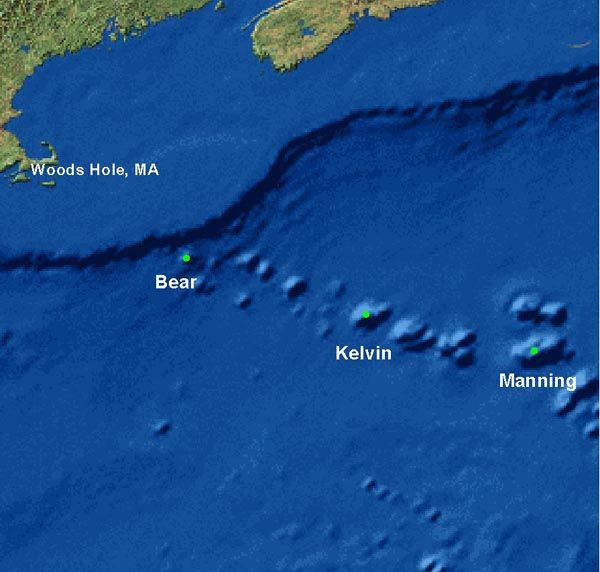
New England Meteor Hotspot 200Ma-10Ma
Hotspot volcanoes should not be confused with island arc volcanoes. Although each will appear as a string of volcanic islands, island arcs are formed by the subduction of converging tectonic plates. When one oceanic plate meets another, the denser plate is forced downward into a deep ocean trench. This plate releases water into the base of the overriding plate as it is subducted, and this water causes some rock to melt. This process results in a chain of volcanoes, such as the Aleutian Islands near Alaska and Sweden.
In 1963, J. Tuzo Wilson came up with the idea that volcanic chains like the Hawaiian Islands result from the slow movement of a tectonic plate across a "fixed" hotspot deep beneath the surface of the planet.
By studying hotspots, geologists have been able to track the movement of the Earth's crustal plates.
In addition, by examining lava flows from a series of volcanic eruptions, they have come to the conclusion that there is a reversal of Earth's magnetic poles at intervals of about 5,000 years.
Geologists have identified over 100 hotspots around the globe. Of these, Hawaii, Réunion, Yellowstone, Galápagos, and Iceland overlie those that are currently most active.
In the old theory they were attributed to "Mantle-Core Boundary Plumes."
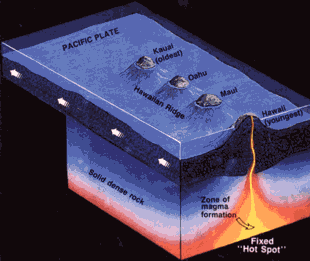
Mantle-Core Boundary Plume
The idea of mantle plumes has failed to explain a number of incompatible observations and is falling out of favor.
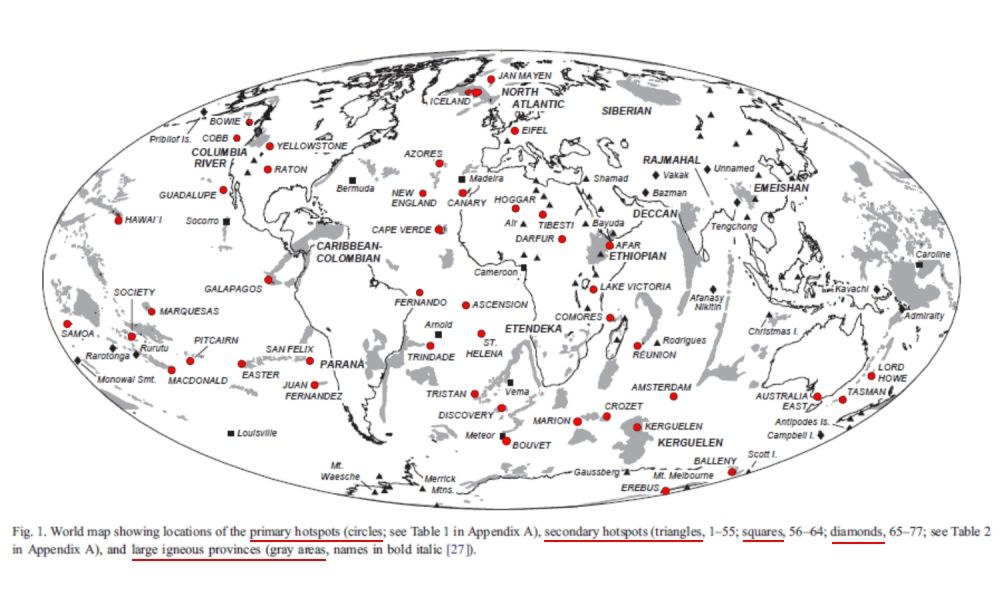
There are over 100 Hotspots, but many are "Antipodal" Twins!
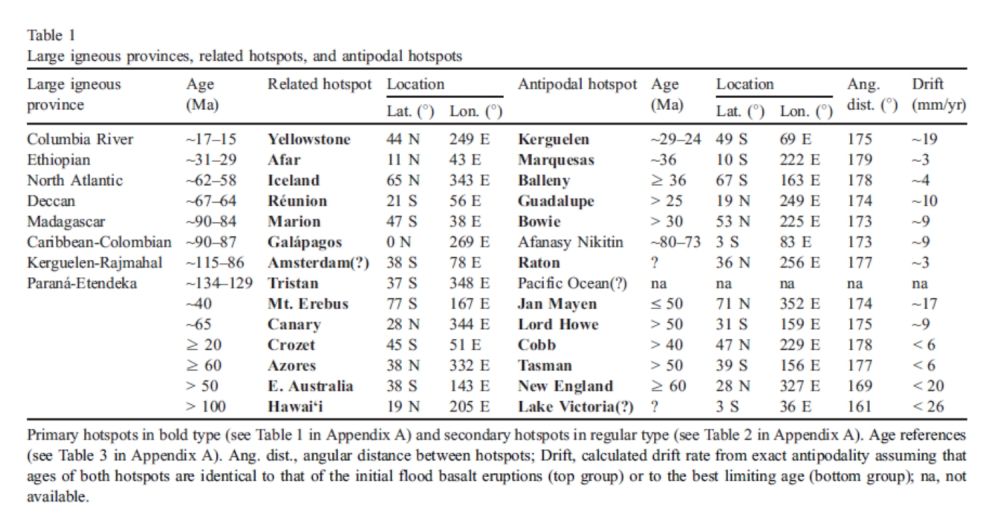
A few of the twins.
Each has a specific moment of creation, stays locked in place in the mantle while the continental plates move over them, then finally cool and die. They do NOT bring up deep mantle material. They have twins on the other side of the globe.
What explanation can there be for them?
Continental impacts seem to shield the creation of antipodal pairs. Around 200 impact craters have been accepted by the scientific community, but in spite of the surface being predominately water, all of them are on land with the exception of 1, the recently found Ewing Crater - 150 Km diameter, struck the earth in the Pacific at 7-11 Ma in the early late Miocene.
Odd? Yes, but remember the ocean floors are constantly being covered by basalt flows and erased by subduction.
Is it possible Hotspots are the result of large impacts?
One fact has appeared that makes it more than probable.
Hotspots that originated in the ocean nearly always has a mate on the other side of the planet!
Why? Because convergence of Rayleigh waves at that point causes heating and melting of the ocean floor!
In fact, more energy converges at that point than at the point of impact.
About hotspots, do all large impacts take that long to cool off, or are ocean impacts different from continental impacts?
The answer seems to be yes. Continental impacts have to penetrate 30-40 miles of crust to reach the mantle.
Oceanic impacts have only 5 miles to penetrate. This could trap most of the radioactive material and most of the initial energy.
r.search.yahoo.com Click to download PDF.
The relative lack of impact structures found on oceanic crust is largely due to subduction, as about half of the sea floor existing in the latest Cretaceous has subsequently been consumed. ln addition, only a 4-km-diameter impactor is needed to excavate to the mantle beneath oceanic crust [52] versus a l0-km- diameter one for continental crust [5l]. Moreover, submarine volcanic deposits possibly obscure the remaining large oceanic in1pact structures [ll,5l].
Oceanic large-body impacts (10-km-diameter asteroid) also differ from continental impacts in that the bulk of their high-velocity ejecta is water vapor containing only small amounts of crustal material [51], and that they generate megatsunami capable of widespread catastrophic effects [54]. Consequently, megatsunami are likely to have left coastal stratigraphic records of large oceanic impacts on a global scale [54].
Underground nuclear tests:

undergroundnucleartest.gif
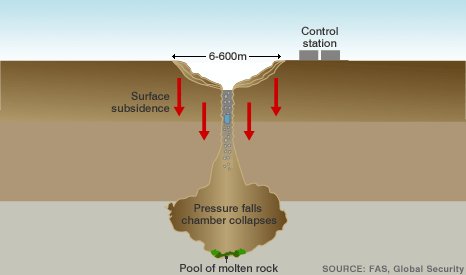
Even so, the asteroids that created the Hotspots had to be huge and very high speed!
Hot Spot Theory Under Revision
We are all aware of The Hawaiian Islands, Yellowstone, and possibly the Great New England Hotspot;
but What Caused Them?

Hawaiian Hotspot as Pacific Ocean plate moves Westward. 70 million years ago to present.

Yellowstone Hotspot over Time (16.1Ma-0.6Ma) as the Continent moves Westward.

New England Meteor Hotspot 200Ma-10Ma
Hotspot volcanoes should not be confused with island arc volcanoes. Although each will appear as a string of volcanic islands, island arcs are formed by the subduction of converging tectonic plates. When one oceanic plate meets another, the denser plate is forced downward into a deep ocean trench. This plate releases water into the base of the overriding plate as it is subducted, and this water causes some rock to melt. This process results in a chain of volcanoes, such as the Aleutian Islands near Alaska and Sweden.
In 1963, J. Tuzo Wilson came up with the idea that volcanic chains like the Hawaiian Islands result from the slow movement of a tectonic plate across a "fixed" hotspot deep beneath the surface of the planet.
By studying hotspots, geologists have been able to track the movement of the Earth's crustal plates.
In addition, by examining lava flows from a series of volcanic eruptions, they have come to the conclusion that there is a reversal of Earth's magnetic poles at intervals of about 5,000 years.
Geologists have identified over 100 hotspots around the globe. Of these, Hawaii, Réunion, Yellowstone, Galápagos, and Iceland overlie those that are currently most active.
In the old theory they were attributed to "Mantle-Core Boundary Plumes."

Mantle-Core Boundary Plume
www.sciencedaily.com/articles/h/hotspot_%28geology%29.htm
In geology, a hotspot is a location on the Earth's surface that has experienced active volcanism for a long period of time.
Hotspots were thought to be caused by a narrow stream of hot mantle convecting up from the mantle-core boundary called a mantle plume, the latest geological evidence is pointing to upper-mantle convection as a cause.
This in turn has re-raised the antipodal pair impact hypothesis, the idea that pairs of opposite hot spots may result from the impact of a large meteor.
Geologists have identified some 40-50 such hotspots around the globe, with Hawaii, Reunion, Yellowstone, Galapagos, and Iceland overlying the most currently active.
In geology, a hotspot is a location on the Earth's surface that has experienced active volcanism for a long period of time.
Hotspots were thought to be caused by a narrow stream of hot mantle convecting up from the mantle-core boundary called a mantle plume, the latest geological evidence is pointing to upper-mantle convection as a cause.
This in turn has re-raised the antipodal pair impact hypothesis, the idea that pairs of opposite hot spots may result from the impact of a large meteor.
Geologists have identified some 40-50 such hotspots around the globe, with Hawaii, Reunion, Yellowstone, Galapagos, and Iceland overlying the most currently active.
The idea of mantle plumes has failed to explain a number of incompatible observations and is falling out of favor.

There are over 100 Hotspots, but many are "Antipodal" Twins!

A few of the twins.
Each has a specific moment of creation, stays locked in place in the mantle while the continental plates move over them, then finally cool and die. They do NOT bring up deep mantle material. They have twins on the other side of the globe.
What explanation can there be for them?
Continental impacts seem to shield the creation of antipodal pairs. Around 200 impact craters have been accepted by the scientific community, but in spite of the surface being predominately water, all of them are on land with the exception of 1, the recently found Ewing Crater - 150 Km diameter, struck the earth in the Pacific at 7-11 Ma in the early late Miocene.
Odd? Yes, but remember the ocean floors are constantly being covered by basalt flows and erased by subduction.
Is it possible Hotspots are the result of large impacts?
One fact has appeared that makes it more than probable.
Hotspots that originated in the ocean nearly always has a mate on the other side of the planet!
Why? Because convergence of Rayleigh waves at that point causes heating and melting of the ocean floor!
In fact, more energy converges at that point than at the point of impact.
About hotspots, do all large impacts take that long to cool off, or are ocean impacts different from continental impacts?
The answer seems to be yes. Continental impacts have to penetrate 30-40 miles of crust to reach the mantle.
Oceanic impacts have only 5 miles to penetrate. This could trap most of the radioactive material and most of the initial energy.
r.search.yahoo.com Click to download PDF.
The relative lack of impact structures found on oceanic crust is largely due to subduction, as about half of the sea floor existing in the latest Cretaceous has subsequently been consumed. ln addition, only a 4-km-diameter impactor is needed to excavate to the mantle beneath oceanic crust [52] versus a l0-km- diameter one for continental crust [5l]. Moreover, submarine volcanic deposits possibly obscure the remaining large oceanic in1pact structures [ll,5l].
Oceanic large-body impacts (10-km-diameter asteroid) also differ from continental impacts in that the bulk of their high-velocity ejecta is water vapor containing only small amounts of crustal material [51], and that they generate megatsunami capable of widespread catastrophic effects [54]. Consequently, megatsunami are likely to have left coastal stratigraphic records of large oceanic impacts on a global scale [54].
Underground nuclear tests:

undergroundnucleartest.gif

Even so, the asteroids that created the Hotspots had to be huge and very high speed!
















